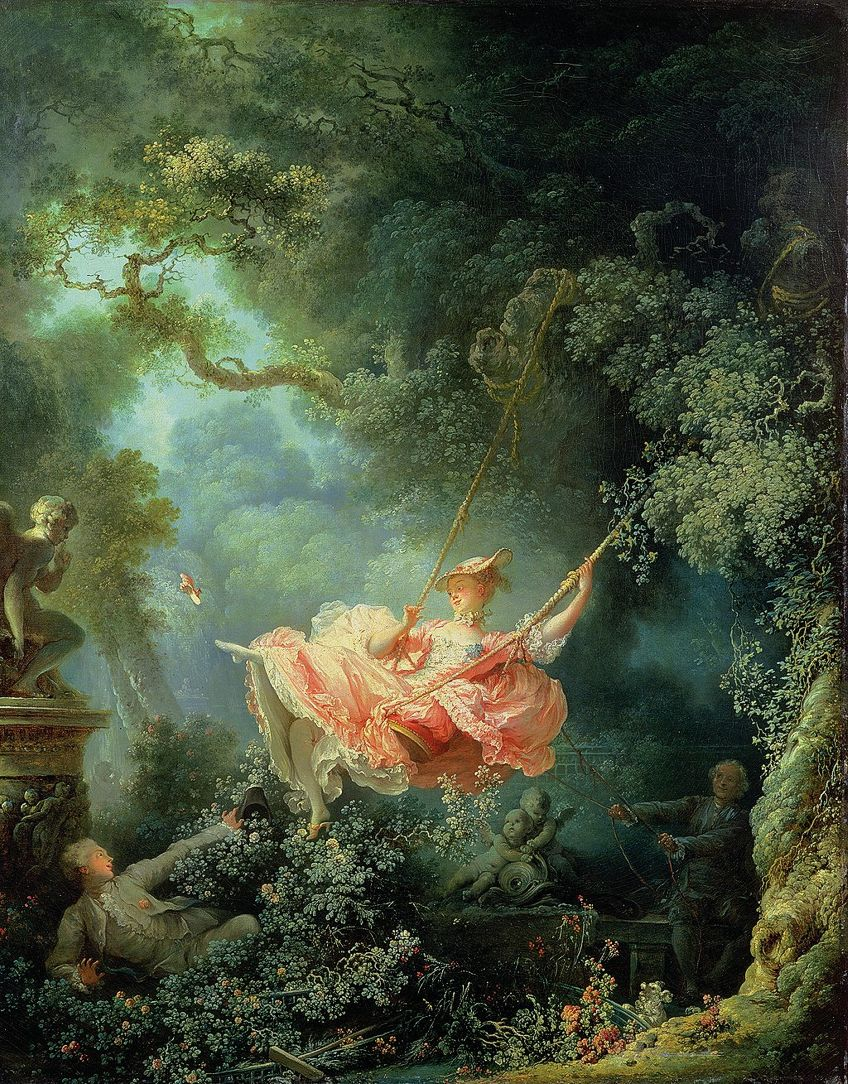Neoclassical and Rococo styles of art painting are seen in the classical era, the period from around 1730-1820 (WikiArt, 2022). Earlier work features the Rococo style. A clear shift was made around 1785 and the latter part of the classical era is dominated by Neo-Classical works. Ladies appear to be well represented during the classical art era and all the work I've selected this week features women.
Rococo style is playful, features the use of pastels, and has a focus of light-heartedness and pleasure. A clear delineation from the use of precision and religious depictions of the Baroque period, Rococo Art is whimsical and has nature-inspired motifs, asymmetrical values, and curving forms (artincontext, 2022). A popular example of Rococo art is The Swing, oil on canvas, by Jean Honore Fragonard. It was painted in 1767 and is now part of the Wallace Collection in London (WikiArt, 2022). I'd love to have this painting. The 'hidden' pictures in the darker corners of the canvas give this painting a feeling of discovery. The lady's foot is pointed and centered and is the focal point of the lightest part of the painting. She seems to be celebrating her femininity and enjoying the company of agreeable companions. The use of pastels on her dress and the playfulness of the scene defined art of this time.
Neoclassicalism developed in part as a reaction to the frivolity of the art produced in Rococo style and it emphasized rational thinking (ArtInContext, 2022). Greco-Roman ideals are prominent in this time of 'high enlightenment' (ArtInContext, 2022). Neo-Classical art moves back to the focus on morality and justice and abandons the fun of the Rococo period. The use of shallow space, dark and subdued colors, and strong lines are characteristic of neoclassical art (ArtInContext, 2022). This is seen in Cornelia, Mother of the Gracchi, Pointing to her Children as Her Treasures (c. 1785) by Angelica Kauffmann and Self-Portrait with Her Daughter (1789) by Elisabeth Louise Vigée Le Brun.
Kauffman's work, Cornelia, Mother of the Gracchi, Pointing to her Children as Her Treasures, is oil on canvas is is on display at the Virginia Museum of Fine Arts in the United States (ArtinContext, 2022). Kauffman was born in Switzerland. This work features Roman architecture as the backdrop and Ancient Roman clothing on both the women and children and is far more 'practical' that works of Rococo style. In this scene, Claudia, the mother of future political leaders, compares her children to the other woman's finery (artincontext, 2022). The mother opens her hands to her children, clearly rejecting material treasures like the necklace the seated woman holds. The woman seated appears to be ashamed or surprised. This painting is all about virtue and morality and clearly positions the woman as keeper of the home and a virtuous woman as one that values family over money. This is one of the earlier works of neo-classical style and was painted the same year as The Swing. It is darker and departs from the use of pastels.
La Brun's Self Portrait with Her Daughter, a work of neoclassical style, is on display at Musee du Louvre in Paris, France. La Brun was a prominent French artist and was commissioned to paint the portrait of Maria Antoinette (ArtinContext, 2022). In this painting, oil on canvas, the dress of the mother and child are reminiscent of Ancient Greek style clothing and the affection between the mother and child is unquestionable. La Brun chose to keep the background dark and minimal which brings the attention to the lightest part of the painting, the embrace between mother and child. The mother's hands are relaxed and the embrace seems genuine. The painting's simplicity brings the viewer to focus on the virtue of the connection between the subjects. Of the two neoclassical style paintings, I prefer La Brun's Self Portrait with Her Daughter. I appreciate its simplicity and the relaxed posture of mother and child.
I found it interesting that the latter two pieces are painted by women, and The Swing, by a man. Would it have been more socially acceptable for a man to dabble in less moral ideas during this time? Based on these works, it may be that women, more so than men, were expected to be of impeccable moral character.
While many classical works still had a focus on depicting historical contexts and Roman ideals, the works shown here have a softer and more inclusive feel. After a brief departure into frivolity and pleasure, as seen in Rococo style paintings, Classical art swings right back to virtue and morality, as seen in neoclassical paintings. The Catholic church continued to have its influence on the art and people of the classical period.
References
Art in Context. (2022). Famous Neoclassical Paintings-Looking at the Best Neoclassical Style Art. (online). Famous Neoclassical Paintings - Looking at the Best Neoclassical Style Art (artincontext.org)
Art in Context. (2022). Famous Neoclassical Paintings-Looking at the Luxurious and Light-Hearted Rococo Period. (online). Rococo Art - Looking at the Luxurious and Light-Hearted Rococo Period (artincontext.org)
WikiArt. Visual Art Encyclopedia. (2022). The Swing. (online). The Swing, 1767 - Jean-Honore Fragonard - WikiArt.org







I love how the paintings you chose feature women! This wasn't that common in that period and if they were featured, it was often for their sexuality, not their character. I especially love the self portrait of the mother hugging her daughter, it truly shows the kindness and love that they feel for one another! Do you think that women artists were able to capture love and emotion better in their paintings than men? Or does it depend on the artist?
ReplyDeleteReading your blog and studying the paintings, I was shocked out how much I missed the meaning behind Kauffman's painting. Originally I just saw two mother's conversing with children running about. It wasn't till after I finished reading your blog that I noticed the difference in the mothers clothes and the real conversation that these two women were discussing. Crazy how much meaning can come to things with context! Thanks for sharing :)
ReplyDelete